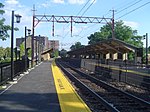Westinghouse Lamp Plant
Bloomfield, New JerseyManhattan Project sitesMetallurgical processesUranium

The Westinghouse Lamp Plant located in Bloomfield, New Jersey, was one of the lamp manufacturing plants of Westinghouse Electric Corporation. The plant had a major involvement in supplying uranium metal for the world's first self-sustaining chain reaction in Chicago (Chicago Pile-1) in the early phase of the Manhattan Project to create the first atomic bomb.
Excerpt from the Wikipedia article Westinghouse Lamp Plant (License: CC BY-SA 3.0, Authors, Images).Westinghouse Lamp Plant
Arlington Avenue,
Geographical coordinates (GPS) Address Nearby Places Show on map
Geographical coordinates (GPS)
| Latitude | Longitude |
|---|---|
| N 40.78137 ° | E -74.19592 ° |
Address
Arlington Avenue 58
07003
New Jersey, United States
Open on Google Maps




